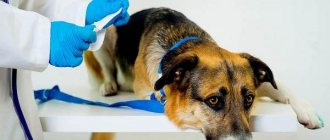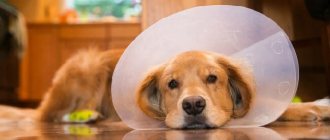The first mention of small Tachichi dogs (presumably the ancestors of the Chihuahua) dates back to the fifth century. Therefore, we can confidently say that this breed has a rich history.
For five centuries (XIV - XIX) babies were on the verge of extinction, but, fortunately, in the 1800s they decided to revive them.
Today, the Chihuahua is one of the most popular dog breeds in the world.
Purebred sneezes are quite expensive. There is no particular need for crossbreeds, so many of us, not wanting to breed crossbreeds (or for other reasons), are asking the question of sterilization and castration.
In our article we will tell you what these procedures are, what their consequences may be, and at what age it is better to have such an operation on a dog.
What are these procedures?
Sterilization and castration are a medical procedure during which an animal is deprived of the ability to reproduce .
Opinions vary regarding the need for this operation.
Some breeders believe that this is a “disfiguring operation that makes a cripple out of an animal” and humans should not interfere with things that nature has designed. Others are guided by the fact that sterilization will reduce the risk of various diseases, and also operate on dogs for reasons of their own comfort.
Below are the advantages of this action:
- life expectancy increases - the dog will live 1.5-2 years longer;
- the pet’s behavior will become more appropriate - aggression towards family members and other dogs will disappear, training will become easier;
- the risk of hormonal diseases and cancer will disappear
IMPORTANT!
Also, at any age, a dog may develop health problems, which may result in the need for sterilization.
There are 3 types of sterilization:
- castration is the removal of the gonads, which entails the cessation of the production of sex hormones. The testes of the cables are cut out, and the ovaries of the bitches;
- sterilization _ For cables, this procedure involves crossing the seed tubes. For females, the procedure is more global - their uterus is cut out;
- chemical castration . The most gentle, because there is no surgical intervention. A special solution is injected into the dog’s withers, which inhibits the dog’s reproductive function. Roughly speaking, the animal loses all thoughts about its offspring. Sexual desire also disappears, so there is no need to worry about changes in behavior during certain periods. By the way, this type of sterilization is reversible. The effect of the drug lasts from 1.5 to 4 years.
The choice of the type of operation remains with the dog's owner.
Castration of a male dog
A surgical procedure to remove both testicles (testes), the paired male gonads, from the scrotum.
Pros:
- blocks male sexual desire, prevents conflicts with potential sexual partners over a female.
- reduces the risk of developing malignant tumors of the prostate gland (prostate) due to the cessation of testosterone production;
- lack of interest in females in heat, so the male stops chasing them;
- balanced and calm behavior;
- a neutered male Chihuahua is easier to socialize and educate, the instinct of dominance is suppressed, and the concentration of attention is increased;
- ceases to relieve hormonal tension on objects and things that, in his opinion, are sexually attractive;
- aggression, as a rule, gives way to friendliness, the animal becomes affectionate and pliable.
Minuses:
- general anesthesia causes more damage to the body than the operation itself;
- the recovery process is slower than after sterilization;
- there may be an increase in appetite, resulting in unwanted excess weight gain. You will have to reconsider your diet to be a little more dietary, but it would be wiser to discuss this issue with your veterinarian.
Is this intervention necessary for a Chihuahua?
There is no need for this operation as such (except when the dog’s health requires it).
For small breeds, sterilization can result in not very good (or rather, very NOT good) consequences in the form of problems with the genitourinary system and a radical change in behavior. And these changes are not always positive.
An advantage of sterilization for owners of female dogs is that the babies stop coming into heat.
In most cases, sterilization has a beneficial effect on the physical and psychological health of the sneeze.
NOTE!
The opinions of various breeders boil down to the fact that if the owner of a Chihuahua does not plan to breed them, then the females must be sterilized to avoid cancer and other terrible diseases.
Regarding the ideal age for surgery on females, the age is 5-6 months (before the first heat). For boys, everything is simpler, because... there are no physiological processes that need to be managed before.
In addition, there is such an unpleasant thing as a false pregnancy. In this situation, the mammary glands of the bitch begin to actively work, but there is no pregnancy itself. This can lead to inflammation of these same glands and their subsequent removal.
The right time for surgery
Before you decide what exactly to do for your Chihuahua - sterilization or castration, you need to carefully consider all the pros and cons. Once any of the operations are done, it will no longer be possible to change anything.
Although surgery can be done at any time, there are some guidelines as to when is the best time to have it done.
It is better to spay or neuter a female Chihuahua before her first heat, that is, at four to six months. A male dog needs to have surgery later, before puberty, at seven to ten months. At such an early age, the likelihood of developing any cancer is minimal.
If you decide to spay or neuter your Chihuahua bitch after giving birth, you need to wait until lactation stops.
There are times when castration is simply necessary. If the disease cannot be cured with medication. For example: orchitis - inflammation of the testicles or injury in the perianal area.
Advantages and disadvantages
For both girls and boys sneezes, the pros and cons of the procedure are almost the same.
The character in most cases becomes more flexible and affectionate. Girls' estrus stops, and boys' desire to mark their territory (including at home) disappears. The reaction to dogs of the opposite sex fades away.
An additional (and perhaps the main) advantage for girls is the elimination of the risk of unplanned pregnancy.
For boys, the period of second childhood begins. They become playful and active again.
The disadvantages include sudden weight gain , possible suppuration of the sutures, lethargy, anesthesia, which in itself negatively affects the cardiovascular system and can also lead to cardiovascular failure.
approximate cost
It should be understood that the exact cost of such an operation depends on the following factors:
Today you can sterilize or neuter a Chihuahua for about 1–4 thousand rubles.
Before you decide whether to spay your Chihuahua, you need to find out all the pros and cons of this type of surgery. Let's look at them in more detail.
Sterilization
You need to understand that sterilization has the only advantage - the animal does not have the opportunity to reproduce, but sexual functions are preserved. After performing this operation, the following disadvantages may appear:
At the same time, boys remain interested in the opposite sex, while girls continue to be in heat.
At what age should I do it?
As mentioned above, the ideal time for sterilization for Chihuahua girls is from 3 to 6 months of age, before the first heat, with the onset of which the gonads begin to produce specific hormones that can (in some cases) provoke the formation of malignant hormone-dependent tumors.
Males can be neutered at any age, but ideally the operation should be done in the first year of life.
IMPORTANT!
Sterilization at a later age becomes dangerous for Chihuahuas, because... there is a risk that the dog will not recover from anesthesia, the heart will fail, or any serious complications will arise.
Sterilization of a male dog
A less invasive surgical method than castration. It consists of ligating or cutting the vas deferens, the connecting link between the testes and the penis, which leads to complete sterility and the inability of the male dog to fertilize. In medical practice, the procedure is called a vasectomy.
Pros:
- minimally invasive procedure compared to castration;
- the operation is performed by a surgeon under local anesthesia together with sedation, which has a more gentle effect on the animal’s body compared to general anesthesia;
- reduces the risk of prostate diseases.
Minuses:
- male hormones continue to be produced, in particular testosterone;
- sexual desire remains, the male continues to pay attention to females;
- the risks of cancerous tumors of the reproductive organs remain;
- the behavior remains the same.
!
Invasiveness means deep interference with the integrity of the internal organs of the biological system of the body.
How to prepare?
Before the operation, it is necessary to fully examine the dog for its health status, take blood and urine tests. Only completely healthy dogs are operated on (to avoid complications). It is also necessary to get all routine vaccinations and get rid of worms.
The owner himself will have to prepare mentally.
The operation lasts on average 20-40 minutes, depending on the type of operation and anesthesia.
For cables, the operation is simpler (lately the testes are removed from the scrotum through a small incision) and will not last long. For bitches, things are more complicated, because in their case a strip operation is performed (whether it is removal of the uterus or ovaries).
Basic Concepts
Sterilization is a type of surgical intervention based on the cessation of the functioning of the ovaries and uterine cavity in females, and interruption of the development of the testes in males.
After it, reproductive function disappears, offspring do not appear, but attraction to individuals of the opposite sex remains.
Castration is the complete removal of reproductive glands in animals. In males - testes, in females - ovaries and uterus. In this case, after the procedure, the behavior of the animals changes, the production of hormones is suppressed, and the need for procreation disappears.
It is carried out to reduce the risk of diseases, the appearance of malignant tumors, and also reduce anxiety and aggression.
One of the most pleasant consequences of castration is that they stop lunging at animals and people and leaving marks in the apartment. The dog's desire for the opposite sex completely disappears, and they give all their love to their owners.
Recovery period
The most exciting period will be the first day after surgery.
The dog may wake up immediately, or it may take several hours. In any case, upon arrival home, you need to place your pet on a bedding on a flat surface (ideally, a floor where he cannot fall). The main sign of impending awakening will be twitching of the limbs.
During the action of the anesthetic, all reflexes of the body are turned off, so uncontrolled emptying is likely! Be prepared to change the bedding.
On the first day, food is contraindicated for the baby! Immediately after waking up, you need to wet the dog’s nose with water and offer him something to drink, but you shouldn’t give him a lot of water.
Dangerous signs after surgery may include:
- uneven breathing (both when waking up after anesthesia and while awake);
- rapid pulse;
- blood in urine;
- suppuration of the suture;
- absence of stool and urine for more than a day (especially lack of elimination of minor needs);
- significant increase in temperature
During the rehabilitation period, the breeder has even greater obligations - it is necessary to treat the stitch and give the dog medications. Most often, veterinary clinics provide a list of necessary ointments and preparations along with instructions for treating sutures.
NOTE!
In addition to medications and suture treatment, a change in diet is required after surgery. Nowadays stores are full of a variety of food for sterilized animals, but it is still better to consult a veterinarian on this issue.
Recovery
Castration or sterilization are simple procedures and recovery after them will not take long. There are no special restrictions, the main thing is to pay attention to the well-being of your pet. The sutures are removed within a week, and resorption occurs quickly.
After this, do not forget to treat this area with anti-inflammatory and antiseptic agents; your veterinarian will prescribe them for you.
You need to feed certain foods, best soft, ground food, porridge, pate. Also, the dog may be prescribed a course of antibiotics.
Take care of absorbent, soft bedding, because sometimes side effects can include diarrhea, vomiting and involuntary urination. Be prepared and stay close to your pet.
Castrate or sterilize?
If you still haven’t decided what is better in your case, castration or sterilization, then I will express my opinion. It is better to castrate a dog that is inclined to show aggression and occupy a dominant position in a relationship, both a girl and a boy.
Oddly enough, such a humane solution helps soften the animal’s character and behavior and concentrate attention due to the absence of pheromone stimuli. It has a beneficial effect on the health of Chihuahuas, because... the risks of developing malignant tumors of the reproductive organs are eliminated due to their absence.
Discomfort, mental and emotional state associated with sexual desire will leave the Chihuahua alone forever. The likelihood of false pregnancy occurring during a well-performed operation to remove the ovaries and uterus in females and postoperative complications are eliminated.
Sterilization would be a good solution for calm and non-aggressive individuals, when the owner prefers not to radically interfere with the pet’s reproductive system. In any case, the choice is up to the owner!
Specifics of marking territory
Before weaning your dog from leaving odorous surprises in the apartment, you need to find out how the mark differs from regular emptying of the bladder.
Label assignment
A mark is the leaving of specific marks on objects or walls of a room. The most favorite places for pranksters are darkened corners of the room, entrance doors, the owner’s bed or sofa.
Before doing a dirty trick, the animal carefully sniffs the selected surface. The dog does this consciously, for a specific purpose: to mark his presence in a specific territory and designate the thing as his property.
It is necessary to distinguish between marks and relief
Small puppies under the age of six months are not able to leave marks. If a puddle appears in the house, it means that the baby has simply peed himself - it is difficult for him to endure for a long time due to the weakness of the bladder muscles.
Relieving yourself indoors is also associated with a long period of abstinence. An adult animal may not be able to stand it and do a wet job if the intervals between walks are too long.
Involuntary emptying of the bladder cannot be considered leprosy. Incontinence occurs in four-legged animals that have experienced severe stress or suffer from cystitis, pyometra, polydipsia, suffer from renal failure, or experience severe pain due to injury.
It is easy to distinguish a mark from incontinence: the former appear more often on vertical surfaces and are not so abundant, while the latter are puddles left on the floor.
Characteristics of the breed
The Chihuahua is the smallest breed in the world. Funny decorative dogs weigh no more than 3 kg. It is assumed that they existed in the wild and were domesticated, and not bred through the efforts of breeders. A well-proportioned animal should have a round head, a slightly upturned nose, a correct bite, large eyes and ears, a wide chest, a tucked belly, small paws and a high tail. The coat can be either short or long. There are no color requirements.
Chikh, as his owners affectionately call him, has a cheerful and lively character, and is very attached to his owner.
Of course, they have both pros and cons. Chihuahuas, like any other miniature breed, have advantages over larger dogs:
But sneeze has advantages not only over large dogs, but also compared to other small breeds:
However, the breed is not without some flaws.
A dog has its own character, which can sometimes cause trouble for its owner. For example, the negative aspects of a Chihuahua are:
In addition, due to its miniature build and fragility, the dog is easy to injure. She is constantly cold, and in stressful situations the sneeze may cause involuntary urination.
If a bitch marks at home
Females are less likely than males to show a desire to leave their mark on furniture or walls. However, during the period of estrus, they demonstrate strange, in human eyes, behavior, including relieving themselves within the walls of their home.
Smelly signs can also indicate a desire to protect the nest with puppies. This is how mom scares off strangers and shows the boundaries of her territory. Typically, this behavior ends after the puppies grow up and begin to move around the entire apartment.
Otherwise, the methods of dealing with marks are similar: obstinate females who strive for leadership or are prone to revenge are carefully trained, and those who become ill are treated under the supervision of a veterinarian. If obtaining offspring is not the goal of having a bitch, then sterilization is carried out.
Aftercare
After the Chihuahua has been operated on, the doctor monitors its recovery from anesthesia. Castrated and sterilized animals are transported in a special basket or carrier with an insulated bottom. You cannot transport your pet on public transport. For two days after surgery, dogs may not eat well, move little, and become lethargic. During this period, it is important to always have a bowl of clean water nearby.
In the postoperative period, daily treatment of sutures with special aseptic substances is necessary.
The doctor prescribes them. To prevent animals from damaging the seams, they are wearing either a diaper or a special collar. Stitches are removed on days 10–14.
Bitches tolerate this type of surgical intervention less well. Therefore, in the first days they should not be left alone for a long time. During this time, they may experience chills and involuntary urination. Dogs should be fed little by little in the first days after surgery. They are switched to a full diet on the fourth day.
Possible reasons
How to react and what to do when a dog marks in an apartment depends on the reason for the action. An attentive owner should trace what caused this behavior and choose an appropriate response.
Experiences, stress, resentment, revenge
Often odorous signs become a manifestation of serious emotional experiences. For example, in this way a male or female demonstrates resentment or feelings. A young and wayward pet that has just been punished can leave marks.
When stressed or frightened, the dog begins to pee on its territory to ward off the stranger. Vengeful individuals do the same, thereby showing superiority over others.
In the end, the dog may wet itself simply from the joy of meeting its owner. This is typical for puppies, and this behavior can be corrected by education.
The desire to gain leadership
Trying to show who is boss in the house, the dog begins to relieve itself on all surrounding objects: furniture, walls, even the clothes of household members. All cases of inappropriate manifestations must be strictly suppressed, showing authority. The dog must understand that there is only one leader in the house - and this is a person.
Sexual hunting
The most common reason for the misdeeds of a four-legged friend is the manifestation of sexual instinct. Both females and males can leave odorous signs for members of the opposite sex. In this way they attract the bride or groom, showing their readiness for mating.
Competition for territory – with people or other pets
In their natural habitat, four-legged animals instinctively mark the territory they inhabit. This helps scare off the stranger and save your dinner - and sometimes your life.
Pets remember their natural instincts when a new animal or person appears in the house or apartment. Some representatives react equally poorly to a kitten or a baby, considering them invaders.
Illness or old age
There are chronic diseases that force a once obedient friend to pee in the corner of the room. Uncontrolled urination is caused by a number of pathologies: cystitis, kidney failure, various types of diabetes.
Old age weakens the bladder muscles. This leads to the development of incontinence. You won’t be able to cope with the problem on your own; you need the help of a veterinarian and treatment under his supervision.
Reluctance to walk outside
Sometimes inappropriate behavior demonstrates the dog's obvious desire to stay at home. Reluctance to go for a walk can be triggered by fright during one of the walks, bad weather or severe mental disorders.










